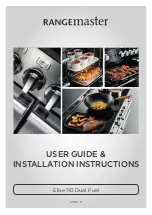
7
Make Gas Connection
To Assemble Pressure Regulator:
1.
Connect the flexible stainless steel connector to the pressure
regulator using a ¹⁄
2
" male pipe thread adapter.
A combination of pipe fittings must be used to connect the
cooktop to the existing gas line. Shown in the following
illustration is a typical connection. Your connection may be
different, according to the supply line type, size and location.
NOTE:
When installing the cooktop above a built-in oven,
install a 90º elbow - ¹⁄
2
" female to ¹⁄
2
" male between the
cooktop manifold pipe and the pressure regulator. The
regulator must be set with the arrow pointing toward the
cooktop. Apply pipe joint compound for use with LP gas to
the end of the cooktop manifold pipe and the male end of
the 90° elbow.
2.
Install the pressure regulator with the arrow pointing up
toward the bottom of the burner box and in a position where
you can reach the regulator.
A. Gas pressure regulator
B. Up arrow - regulator must be installed
with arrow pointing up at cooktop bottom.
C. Adapter - must have
1
/
2
" male pipe thread
D. UL listed or CSA approved flexible
stainless steel gas supply line
IMPORTANT:
All connections must be wrench-tightened. Do
not make connections to the gas regulator too tight. Making
the connections too tight may crack the regulator and cause
a gas leak. Do not allow the regulator to turn on the pipe when
tightening fittings.
Use only pipe-joint compound made for use with Natural and
LP gas.
Do not use TEFLON
®
tape. You will need to determine the fittings
required depending on your installation.
Typical flexible connection
1.
Apply pipe-joint compound made for use with LP gas to the
larger thread ends of the flexible connector adapters (see D
and F in the following illustration).
2.
Attach 1 adapter to the gas pressure regulator and the other
adapter to the gas shutoff valve. Tighten both adapters.
3.
Use a
15
⁄
16
" combination wrench and channel lock pliers to
attach the flexible connector to the adapters. Check that
connector is not kinked.
No appliance/obstructions
below cooktop
Suggested installation to
avoid interference below
cooktop
A
B
D
E
C
F
G
H
I
A
B
C
D
F
I
J
K
H
E
G
A. Manifold entrance
B. Gas pressure regulator
C. Use pipe-joint compound.
D. Adapter (must have
1
/
2
" male
pipe thread)
E. Flexible connector
F. Adapter
G. Use pipe-joint compound.
H. Manual gas shutoff valve
I.
1
/
2
" or
3
/
4
" gas pipe
A. Manifold entrance
B.
3
/
8
" elbow
C. Use pipe-joint compound.
D. Adapter (must have
3
/
8
" male
pipe thread)
E. Flexible connector (pass
through wall between cabinets)
F. Adapter (must have
3
/
8
" male
pipe thread)
G. Use pipe-joint compound.
H. Appliance pressure regulator
(supplied)
I.
1
/
2
" or
3
/
4
" gas pipe
J. Manual gas shutoff valve
K.
1
/
2
" or
3
/
4
" gas pipe
WARNING
Explosion Hazard
Use a new CSA International approved gas supply line.
Install a shut-off valve.
Securely tighten all gas connections.
If connected to LP, have a qualified person make sure
gas pressure does not exceed 14" (36 cm) water
column.
Examples of a qualified person include:
licensed heating personnel,
authorized gas company personnel, and
authorized service personnel.
Failure to do so can result in death, explosion, or fire.
A
B
C
D
Summary of Contents for JGC2536EB
Page 19: ...19 Notes ...






































